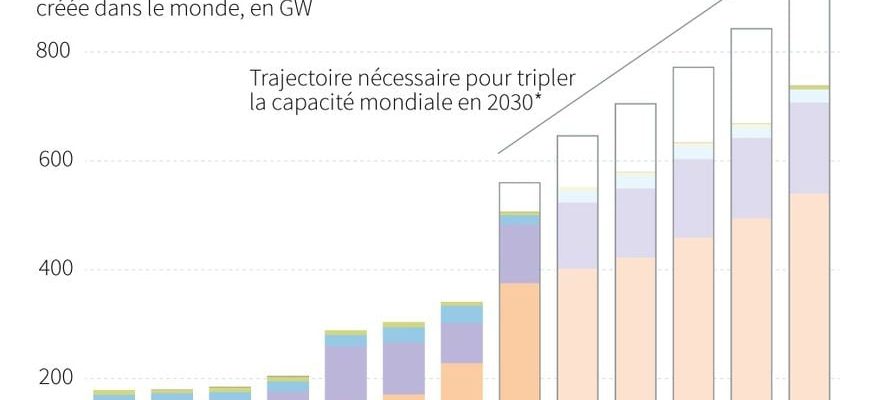This is still insufficient in the face of global warming. But the world installed 50% more renewable electricity capacity last year compared to 2022, according to the International Energy Agency (IEA), which anticipates an unprecedented rate in the years to come.
Some 507 gigawatts (GW) were put into service, or 50% more than in 2022, according to the Renewables 2023 report published Thursday by the IEA. Three-quarters of these new installations in 2023 were in photovoltaic solar.
China was once again the major driver of this growth (+66% of wind turbines over one year for example). But Europe, the United States and Brazil have also reached unprecedented levels.
Renewable energies: accelerated development but still insufficient
© / afp.com/Valentin RAKOVSKY, Anibal MAIZ CACERES
The strongest growth in thirty years
The IEA anticipates for the next five years the “strongest growth” ever seen in thirty years. “Renewable electricity generation capacity has never expanded so rapidly in 30 years, giving a real chance of achieving the goal governments set at COP28 of tripling global capacity by 2030″, underlines the IEA.
However, this pace is not yet sufficient, adds the Agency, which highlights in particular the need for financing for emerging and developing countries.
“In market conditions and the state of current policies, global capacity would be multiplied by 2.5 by 2030. This is not yet enough to achieve the tripling objective of COP28, but we are sure “is approaching, and governments have the necessary tools to make up the difference”, summarizes the director of the IEA Fatih Birol.
Support developing countries
“Onshore wind and photovoltaics are cheaper today than new fossil fuel power plants almost everywhere, and less expensive than power plants already installed in most countries,” underlines the economist.
Last year notably saw the prices of photovoltaic modules fall by almost 50% over one year, and this movement should continue with the observed increase in manufacturing capacities, notes the agency, created exactly 50 years ago by the OECD when it came to responding to the oil shock. The situation is more delicate for the wind industry outside China and particularly in Europe where it is affected by the increase in production costs, interest rates and the length of procedures for obtaining permits.
The objective of tripling renewable energies is understood at the global level, with different needs from one country to another. On the side of rich countries and large emerging countries, the IEA underlines the need to put an end to hesitation in national policies, to invest in the modernization and adaptation of networks, to reduce delays and administrative complications.
For other countries, access to financing and the establishment of robust regulatory frameworks will be decisive, the report adds. As well as the setting of renewable installation objectives, objectives still absent in certain countries.
For Dave Jones, from the Ember think tank, “the level reached in 2023 shows that a tripling is completely achievable”. If we add progress in energy efficiency, “we are moving more and more not only towards a peak in demand for fossils this decade but towards a drop in the size of their consumption”, he believes. For him, in 2024, renewables will be “an existential threat” for the oil, gas and coal industry.
“Renewable energy production is growing quickly, but not fast enough,” noted Dean Cooper, for the WWF: after COP28, “those who want a livable planet must increase pressure on their governments so that they “put words into action and urgently transform energy systems.”
On the other hand, the IEA on Thursday dampened hopes of an upcoming massive boom in green hydrogen, estimating that only 7% of announced projects should come into service by 2030, due to a lack of investment and sufficiently sustained demand.
